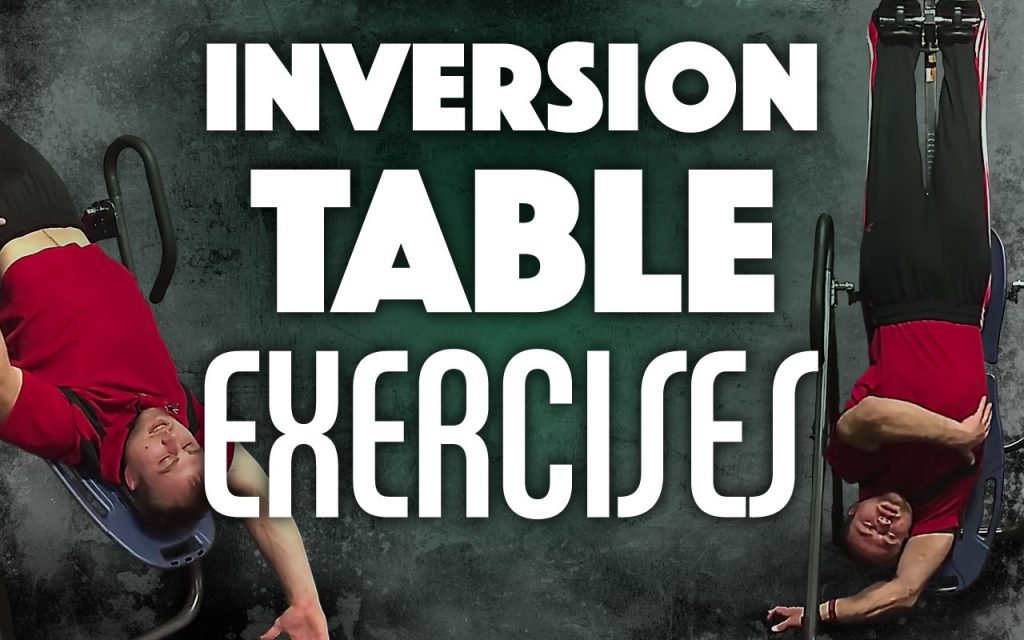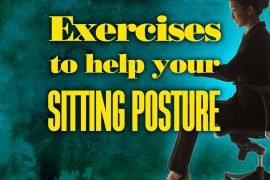[Updated on 1 January 2023] Ever thought of hanging down as a positive exercise? Bats seem to like it, and you will soon after you learn about the benefits. You’ve probably seen the ads on Inversion tables; they are devices that have been designed to let you hang upside down to relieve back pain. It increases circulation decompress your joints while at the same time offering an overall sense of good health; just like you would after a yoga session.
Inversion tables have your normal long table design with a hinge located at the center with a designated space where your legs and feet as you hang on an anchor. While on the device, the user fastens their feet, slowly tilting their head in a head-down position until they are able to get to the desired angle.
Who can benefit from an inversion table?
Table of Contents
Physicians and therapists rely on the inversion table for patients that have chronic neck or low back pain. The inversion table is also beneficial for patients with disk herniation conditions or nerve pain or even compression of a nerve root.
Can Inversion table Exercise Help with back pain?
 Inversion tables can be used to take off the pressure of a person’s spine, increase blood circulation and open up the vertebrae. However, according to studies, the evidence of its benefits is mixed, and inversion therapy might not be recommended for everyone, especially if you have glaucoma or high blood pressure.
Inversion tables can be used to take off the pressure of a person’s spine, increase blood circulation and open up the vertebrae. However, according to studies, the evidence of its benefits is mixed, and inversion therapy might not be recommended for everyone, especially if you have glaucoma or high blood pressure.
According to the 2017 clinical guidelines from the American College of Physicians, while inversion therapy may not be harmful to healthy people, there is very little good quality evidence for their effectiveness over other techniques. The theory behind inversion therapy is when an individual is inverted with their feet above their heads; it’s possible to reverse the effect gravity has on the body.
Gravity affects the muscle causing the joints, muscles, and bones in your back to compress the spine over time, contributing to back pain. Inversion exercises are believed to decompress the spine, much like physical manipulation or gentle massage or and could allow people to find some relief and symptoms such as chronic back pain. It’s important to only use the inversion table with the under the advice of a physician.
Benefits of Inversion Tables
 According to the ACP, the benefits of using an inversion table or therapy are not conclusive. However, several physicians and health facilities that use the inversion table find a few benefits from the regular use of the equipment.
According to the ACP, the benefits of using an inversion table or therapy are not conclusive. However, several physicians and health facilities that use the inversion table find a few benefits from the regular use of the equipment.
Spinal health improvement
Gravity works by putting pressure on our muscles and spine at the back to keep your body upright, forcing the spine to decompress overtime. Physical manipulation of the spine, muscle strengthening as massages are other techniques used to release compression. Therefore, holding your body upside down might stretch the spine in a similar fashion as these techniques.
Just like Yoga, using the inversion table may improve the overall health of your spine and ligaments, reducing the pressure of the muscles in the area. The result is more comfortable movements and overall body flexibility.
Decreased pain
According to a study that looked at the effect of inversion traction on pain, muscle strength, and low back flexibility in patients, it was discovered that the inversion traction used at an angle of 60 degrees helped reduce back pain improving the strength of trunk extensor muscle and lower back flexibility strength in patients on patients who were on an eight week program.
Improved flexibility
The flexibility of the spine is very important since it allows the joints to move through their full range of motion maintaining good balance, posture and to help prevent injuries. According to the previously mentioned study, it was also discovered that there was a significant change in trunk flexibility after going through a specified period program.
Muscle relaxation
When your body is inverted, the muscles of the trunk at the back are pulled by the weight of the body; this allows them to lengthen and stretch, contributing to increased relaxation. However, there’s very little concrete evidence that supports changes in the body due to traction. While it may help take off some pressure on compressed nerves, without functional restoration through chiropractic care and physical therapy, the overall results may be temporary.
Using an inversion table
So how do you use an inversion table? Well, using an inversion table is much like using a sauna. While there are massive benefits, there are a few things you need to be aware of. While the inversion table can increase both your blood pressure and pulse rate, it might not be advisable if you are overweight, have blood pressure or other cardiovascular issues, or plaguing in your arteries, unless your doctor or physicians advise you to do so.
Initial Inversion Stretching Exercise
 While on the inversion table, you can slowly stretch your entire body outwards. This is a great way to exercise your torso by arching it from side to side. This allows you to lose your muscles surrounding it, while at the same time stretching the lower or mid-spine section. Yet another efficient stretching you can do is to cross your single arm over the entire body while at the same time gripping the other side of the inversion table. Once you have a good grip, rotate it towards the shoulder while doing a stretch.
While on the inversion table, you can slowly stretch your entire body outwards. This is a great way to exercise your torso by arching it from side to side. This allows you to lose your muscles surrounding it, while at the same time stretching the lower or mid-spine section. Yet another efficient stretching you can do is to cross your single arm over the entire body while at the same time gripping the other side of the inversion table. Once you have a good grip, rotate it towards the shoulder while doing a stretch.
These inversion exercises are great and can be done at any time for as long as you like. You can also stretch your neck through the inversion table and rotate your head from right to left. It’s also possible to lift your head ensuring you don’t sit up.
The Risks of Inversion Therapy
 It’s important to note that while inversion therapy is good for your body, there are a few risks involved. Suspending your body upside down decreases your heart rate, while at the same time increasing your body pressure, this exerts a lot of pressure on the inner ear and the eyeballs. Due to this, individuals with the following conditions might not be the best fit for inversion exercise or therapy.
It’s important to note that while inversion therapy is good for your body, there are a few risks involved. Suspending your body upside down decreases your heart rate, while at the same time increasing your body pressure, this exerts a lot of pressure on the inner ear and the eyeballs. Due to this, individuals with the following conditions might not be the best fit for inversion exercise or therapy.
- Heart disease
- High blood pressure
- A hernia
- History of Stroke
- Broken bones
- Osteoporosis
- Obesity
If you have conditions that affect your head, its advisable to stay clear of inversion therapy. Some of these conditions include:
- Pink eye
- Ear infections
- Retinal Detachment
- Glaucoma
Inversion therapy is also not advisable for people who are using blood clotting or blood pressure medications. This therapy is also not suitable if you are pregnant.
Full Inversion Stretches
The Inverted Crunch
To perform this exercise; place your hands on your chest or head area and lift your torso halfway towards your knees. You will immediately feel a powerful sensation that is a result of the activity from your muscles.
Sit-ups
Like inverted crunches, place your hands above your head and do some sit-ups with your knees. In case you are struggling with your sit-ups when in a fully inverted position; use your hands to support your knees. For most people, inverted sit-ups can be hard to pull off. According to researchers, these exercises are three times more challenging than normal sit-ups. It’s important to make sure that you get the exercise right and that you are safe.
Inverted squats
In a fully inverted position, use your hamstrings and glutes to pull your weight up. This very challenging exercise helps in strengthening the hamstrings and glutes. Most individuals with low back pain have weak hamstrings and glutes that often contribute to the pain.
Inverted Compression
While in a fully inverted position, reach towards the opposite hand to the table legs. Then force yourself into the rotation, then switch arms and do the same for the opposite direction. This exercise is a great way to help you improve flexibility. While at the same time tightening the muscles along your side.
Increased decompression
In a fully inverted position, get a hold of the table legs and pull down. This motion helps to increase and control the amount of decompression in case you want or need more.
Can Inversions Tables work for other conditions?
Inversion therapy exercises are typically used as a non-invasive answer to sciatica and back pain disorders, and especially for people who want to seek alternative methods other than surgery. It’s important to take extreme caution when considering back surgery. Most people who have had back surgery confess even though some of the most intense problems were solved with the procedure, they never really went back to normal. Therefore, exhausting other alternatives such as inversion therapy is a worthwhile option before going for back surgery. According to James Cook University Hospital, getting Inversion therapy may significantly help reduce the need to go in for back surgery for some individuals.
Inversion Therapy and Kidney Stones
Kidney stones are a hell-ride experience. When they pass, the pain is intense and excruciating, and individuals with large stones may end up having other complications. So how can inversion therapy help individuals with Kidney stones?
During Kidney stone treatment, there’s a procedure known as extracorporeal shock wave lithotripsy; it’s a procedure where targeted shock waves are delivered through the body to break up the kidney stones into smaller pieces to help them move easily. During the procedure, some of the kidney stone fragments will remain. In such situations, considering an inversion therapy may help the body push out the remnant kidney stones as observed by multiple studies.
Types of Inversion Therapy
To conduct, inversion therapy, there is a need for special equipment, that is where inversion tables come in handy. However, it’s important to note that inversion tables are not the only equipment needed for inversion therapy; you could also use specialized chairs and gravity boots.
Getting inversion therapy equipment is relatively easy since the equipment is inexpensive. Please note that most insurance companies will not cover the cost of alternative therapies. Examples of inversion equipment other than inversion table include:
Inversion chairs
Inversion chairs are a type of inversion therapy that uses a specially designed chair to allow a person to hang upside down. The chair is designed to support the person’s ankles and allow them to invert at different angles, depending on their needs and comfort level. This type of therapy is an effective way to improve flexibility, strength, balance, and circulation, and can also be helpful in relieving back pain, stress, and tension. Inversion chairs are a non-impact form of exercise, and are suitable for people of all ages and fitness levels. They are also relatively easy to use, and can be adjusted to suit the individual’s needs. This type of therapy is a great option for people who may find inversion tables or gravity boots uncomfortable or difficult to use. It is also a good alternative for those who want to achieve the benefits of inversion therapy without having to do a handstand or other acrobatic maneuvers.
Gravity boots
Hand-stand
Hand-stand therapy is an inverted exercise that uses the power of gravity to improve overall health and wellness. It is a type of inversion therapy that is done by assuming an upside-down position supported by the hands. This therapy has been used for centuries to improve flexibility, strength, balance, and circulation. It is a non-impact form of exercise that can be beneficial for individuals of all ages and fitness levels. Hand-stand therapy is a great way to boost the immune system, reduce stress and tension, and improve the overall health of the body. It is a challenging but effective form of exercise that can help to improve posture, core strength, and balance. It can also help to improve blood flow and oxygenation to the brain and other vital organs.
Yoga Inversions
Yoga inversions are a type of inversion therapy that incorporates various yoga poses that involve being upside down. These poses are designed to improve flexibility, balance, and strength while also promoting a sense of calm and relaxation. Inversions are a powerful tool for rejuvenating the body and mind and can help to increase blood flow to the brain, improve posture and core strength, and reduce stress and tension. Yoga inversions are the perfect way to boost the immune system and improve overall health and wellness. Some of the most popular yoga inversions include the headstand, the shoulder stand, and the handstand. These poses require a certain level of strength and flexibility and are typically practiced by more experienced yogis. However, with proper guidance and instruction, anyone can learn to practice yoga inversions safely and effectively.
Acro Yoga Inversions
Acro yoga inversions are a type of inversion therapy that involves a partner to help achieve the inversion by using their body to assist and support the person being inverted. This form of therapy combines elements of acrobatics, yoga, and therapeutic massage. It is a fun and dynamic practice that can improve strength, flexibility, balance, and trust between partners. This practice is particularly effective for those who are looking to build trust, improve communication and deepen their connection with others. Acro yoga inversions can help to build trust, communication, and connection between partners. It is also a perfect way to relieve stress and tension, improve blood flow, and boost the immune system. This type of inversion therapy is particularly beneficial for those who are looking for a fun and dynamic way to improve their overall health and wellness.
Things to Take Care of While using an Inversion Table
- Consult with a doctor before using an inversion table if you have any pre-existing medical conditions, like high blood pressure, heart disease, or glaucoma.
- Start with a low angle of inversion and gradually increase it as your body becomes more accustomed to the table.
- Do not invert for long periods of time, as this can cause blood to pool in the head and cause dizziness or nausea.
- Use proper form and technique when inverting, keeping your back straight and engaging your core muscles.
- Wear an item of comfortable, loose-fitting clothing and remove any jewelry or sharp objects before using the table.
- Make sure the table is securely locked in place, and the safety straps are properly adjusted before inverting.
- Do not use the table if you are under the influence of drugs and alcohol, as this can impair your balance and coordination.
- If you experience any discomfort or pain while using the table, discontinue use and consult with a doctor.
FAQs
How often should I use an inversion table?
It is recommended to start with a few minutes at a time and gradually increase the duration as your body adapts. It is also essential to listen to your body and not overdo it.
Are there any precautions that should be taken when using an inversion table?
It is important to use an inversion table under the supervision of a professional and make sure it is adjusted correctly to avoid any injury. It is also important to avoid inverting if you are feeling sick or dizzy.
Is it safe to use an inversion table while pregnant?
It is not recommended to use an inversion table during pregnancy, as the inversion can put pressure on the uterus and could be dangerous for the baby. It is perfect to consult with a medical professional before using an inversion table if you are pregnant or planning to become pregnant.
How long should inversion exercises last?
Well, the answer depends, however, it is advisable that you begin with about one or two minutes per session advancing as you feel comfortable. It’s important to keep in mind that inverting more often is much more important than the duration you take during inversion.
Throughout your therapy or exercises, work up to three to five minutes or as long as it takes to help you relax and release your muscles. There is no predetermined time to which an individual can use an inversion table. However, it is vital to listen and respond to your body. Keep in mind, that inversion is all about enjoyment and relaxation.
How often should I use the inversion table?
For maximum results, it is recommended that you routinely invert several times a day. Using the inversion table is a great morning wake-up routine or an evening wind-up technique for a healthy good night’s sleep. You could also incorporate inversion with your regular fitness routine for maximum effects and benefits.
Bottom Line
While there is a lot of evidence to support the use of inversion tables or gravity-assisted traction equipment, a 2013 study by Cochrane review concluded that there isn’t enough concrete evidence to conclude that traction helps patients with lower back pain. The review evaluated about 32 random trails a found out that there was little to no impact on the pain intensity, global improvement, functional status or return to work among individuals that had lower back pain.








